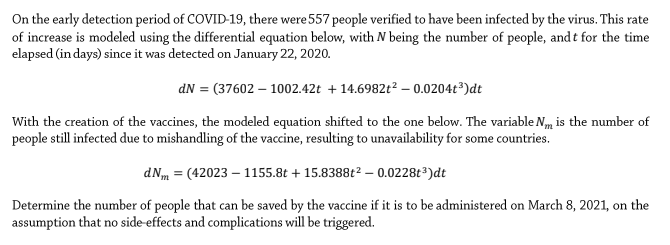On the early detection period of COVID-19, there were 557 people verified to have been infected by the virus. This rate of increase is modeled using the differential equation below, with N being the number of people, and t for the time elapsed (in days) since it was detected on January 22, 2020. dN = (37602 – 1002.42t +14.6982t² – 0.0204t³)dt With the creation of the vaccines, the modeled equation shifted to the one below. The variable Nm is the number of people still infected due to mishandling of the vaccine, resulting to unavailability for some countries. dNm = (42023 – 1155.8t + 15.8388t² – 0.0228t³)dt Determine the number of people that can be saved by the vaccine if it is to be administered on March 8, 2021, on the assumption that no side-effects and complications will be triggered.
On the early detection period of COVID-19, there were 557 people verified to have been infected by the virus. This rate of increase is modeled using the differential equation below, with N being the number of people, and t for the time elapsed (in days) since it was detected on January 22, 2020. dN = (37602 – 1002.42t +14.6982t² – 0.0204t³)dt With the creation of the vaccines, the modeled equation shifted to the one below. The variable Nm is the number of people still infected due to mishandling of the vaccine, resulting to unavailability for some countries. dNm = (42023 – 1155.8t + 15.8388t² – 0.0228t³)dt Determine the number of people that can be saved by the vaccine if it is to be administered on March 8, 2021, on the assumption that no side-effects and complications will be triggered.
MATLAB: An Introduction with Applications
6th Edition
ISBN:9781119256830
Author:Amos Gilat
Publisher:Amos Gilat
Chapter1: Starting With Matlab
Section: Chapter Questions
Problem 1P
Related questions
Question
Applications of

Transcribed Image Text:On the early detection period of COVID-19, there were 557 people verified to have been infected by the virus. This rate
of increase is modeled using the differential equation below, with N being the number of people, and t for the time
elapsed (in days) since it was detected on January 22, 2020.
dN = (37602 – 1002.42t + 14.6982t² – 0.0204t³)dt
With the creation of the vaccines, the modeled equation shifted to the one below. The variable Nm is the number of
people still infected due to mishandling of the vaccine, resulting to unavailability for some countries.
dNm = (42023 – 1155.8t + 15.8388t2 – 0.0228t³)dt
Determine the number of people that can be saved by the vaccine if it is to be administered on March 8, 2021, on the
assumption that no side-effects and complications will be triggered.
Expert Solution
This question has been solved!
Explore an expertly crafted, step-by-step solution for a thorough understanding of key concepts.
Step by step
Solved in 4 steps

Knowledge Booster
Learn more about
Need a deep-dive on the concept behind this application? Look no further. Learn more about this topic, statistics and related others by exploring similar questions and additional content below.Recommended textbooks for you

MATLAB: An Introduction with Applications
Statistics
ISBN:
9781119256830
Author:
Amos Gilat
Publisher:
John Wiley & Sons Inc

Probability and Statistics for Engineering and th…
Statistics
ISBN:
9781305251809
Author:
Jay L. Devore
Publisher:
Cengage Learning

Statistics for The Behavioral Sciences (MindTap C…
Statistics
ISBN:
9781305504912
Author:
Frederick J Gravetter, Larry B. Wallnau
Publisher:
Cengage Learning

MATLAB: An Introduction with Applications
Statistics
ISBN:
9781119256830
Author:
Amos Gilat
Publisher:
John Wiley & Sons Inc

Probability and Statistics for Engineering and th…
Statistics
ISBN:
9781305251809
Author:
Jay L. Devore
Publisher:
Cengage Learning

Statistics for The Behavioral Sciences (MindTap C…
Statistics
ISBN:
9781305504912
Author:
Frederick J Gravetter, Larry B. Wallnau
Publisher:
Cengage Learning

Elementary Statistics: Picturing the World (7th E…
Statistics
ISBN:
9780134683416
Author:
Ron Larson, Betsy Farber
Publisher:
PEARSON

The Basic Practice of Statistics
Statistics
ISBN:
9781319042578
Author:
David S. Moore, William I. Notz, Michael A. Fligner
Publisher:
W. H. Freeman

Introduction to the Practice of Statistics
Statistics
ISBN:
9781319013387
Author:
David S. Moore, George P. McCabe, Bruce A. Craig
Publisher:
W. H. Freeman